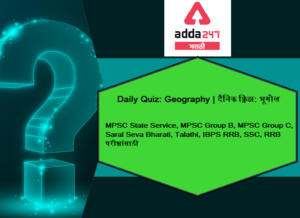
भूगोल दैनिक क्विझ मराठीमध्ये: 11 मे 2021
महाराष्ट्र राज्य लोकसेवा आयोग दरवर्षी वेगवेगळ्या परीक्षे मार्फत हजारो विद्यार्थ्यांची भरती करून घेते MPSC State Service, MPSC Group B, MPSC Group C, Saral Seva Bharati, Talathi, IBPS RRB, SSC, RRB अशा अनेक परीक्षांमार्फत हजारो जागांची भरती दरवर्षी निघते ज्यात लाखो इच्छुक हजार किंवा त्याहूनही कमी जागांसाठी अर्ज करतात. आपण एमपीएससी आणि इतर परीक्षाची तयारी करत असाल तर आपल्याला क्विझ देण्याचे महत्त्व माहित असलेच पाहिजे. बर्याच विद्यार्थ्यांना अभ्यासाचे पुरेसे तास दिले जात असतानाही त्यांना या परीक्षांची पूर्तताही करता आली नाही कारण ते त्यांचे पुनरीक्षण वेळेवर पूर्ण करू शकत नाहीत आणि संशोधन करण्याचा उत्तम मार्ग म्हणजे त्या संबंधित विषयाची किंवा विषयाची क्विझ देणे कारण आपण या मार्गाने कव्हर करू शकता कमी वेळात जास्तीत जास्त विषय. आम्हाला Add 247 मराठी येथे चांगल्या अभ्यास सामग्रीचे मूल्य समजले आहे आणि म्हणूनच आम्ही सर्व विषयांसाठी आपल्याला क्विझ प्रदान करीत आहोत. दैनिक क्विझ देऊन तुम्ही तुमच्या तयारीची पातळी तपासू शकता.
सर्व स्पर्धात्मक विषयांमध्ये भूगोलाचाही तेव्हडाच महत्वाचा वाटा आहे. तर चला भूगोल बद्दल तुमची तयारी तपासण्यासाठी खालील 11 मे 2021 ची भूगोल ची दैनिक क्विझ पहा.
Q .1. कोरिओलिस फोर्स संदर्भात खालील विधानांवर विचार करा:
- कोरिओलिस प्रभाव खांबापेक्षा भूमध्यरेखाजवळ अधिक प्रबळ आहे.
- हालचाल करणार्या वस्तूंच्या गतीमध्ये वाढ झाल्याने कोरीओलिस बल वाढते.
वर दिलेली कोणती विधान बरोबर आहे / विधाने बरोबर आहेत?
(a) फक्त1
(b) फक्त 2
(c) दोन्ही 1 आणि 2
(d) 1 किंवा 2 देखील नाही
Q2. त्रिभुज प्रदेश तयार करण्यासाठी खालीलपैकी कोणती अनुकूल परिस्थिती नाही?
(a) वरच्या भागात सक्रिय धूप
(b) भरतीची उपस्थिती
(c) उथळ किनार
(d) नदीच्या तोंडावाटे कोनाकडे तीव्र धाराची अनुपस्थिती
Q3. खालील जोड्या विचारात घ्या
- गिरिडोह: झारखंड
- ताल्चर: मध्य प्रदेश
- सिंगरौली: पश्चिम बंगाल
वर दिलेली कोणती जोडी योग्य आहे / आहेत?
(a) 1 आणि 2
(b) फक्त 2
(c) फक्त 3
(d) फक्त1
Q4. पावसाळी खंड घटनेचे खालील पैकी कोणते वर्णन केले आहे?
(a) साधारण पर्जन्यमानाच्या सरासरीच्या 75% पेक्षा कमी पाऊस पडल्यास कोणत्याही भागात पावसाची कमतरता असते.
(b) जेव्हा काही दिवस पाऊस पडल्यानंतर दक्षिण-पश्चिम मान्सून काळात एक किंवा अधिक आठवडे पाऊस पडत नाही.
(c) अरबी समुद्र शाखा आणि बंगालच्या उपसागरामध्ये पावसाळ्याच्या वाराचे विभाजन.
(d) हिंसक मेघगर्जनेसह व विजांशी निगडीत आर्द्रतेने वारा वाहण्याची अचानक सुरुवात
Q5. खालील विधानांवर विचार करा
- भ्रंशीय पर्वत मध्ये पृथ्वीच्या कवचचे दाब आणि तणाव दोन्ही समाविष्ट आहेत, तर वलीय डोंगरावर प्रामुख्याने संकुचन समाविष्ट आहे.
- अँडीज हे भ्रंशीय पर्वतांचे उदाहरण आहे
वर दिलेली कोणती विधान बरोबर आहे / विधाने बरोबर आहेत?
(a) फक्त 1
(b) फक्त 2
(c) दोन्ही 1 आणि 2
(d) 1 किंवा 2 देखील नाही
Q 6. वलीय डोंगरासंदर्भात खालील विधानांवर विचार करा.
- त्यात बरेच सक्रिय ज्वालामुखी आहेत आणि खनिज-समृद्ध आहेत.
- आल्प्स पर्वत हे वलीय पर्वतांचे उदाहरण आहे
वर दिलेली कोणती विधान बरोबर आहे / विधाने बरोबर आहेत?
(a) फक्त 1
(b) फक्त 2
(c) 1 आणि 2
(d) 1 किंवा 2 देखील नाही
Q7. समुद्राच्या खंदकांविषयी खालील विधानांचा विचार करा
- ते भिन्न प्लेटच्या सीमेवरील आहेत.
- टोंगा खंदक प्रशांत महासागरात आहे.
वर दिलेली कोणती विधान बरोबर आहे / विधाने बरोबर आहेत?
(a) फक्त 1
(b) फक्त 2
(c) दोन्ही 1 आणि 2
(d) 1 किंवा 2 देखील नाही
Q8. खालील विधानांवर विचार करा
- अक्षांश हे भूमध्यरेखाच्या उत्तरेस किंवा दक्षिणेस पृथ्वीच्या पृष्ठभागावरील कोनाचे अंतर म्हणून मोजले जाते.
- स्थानाचे अक्षांश आणि रेखांश दोन्ही पृथ्वीच्या मध्यभागी मोजले जातात.
वर दिलेली कोणती विधान बरोबर आहे / विधाने बरोबर आहेत?
(a) फक्त 1
(b) फक्त 2
(c) दोन्ही 1 आणि 2
(d) 1 किंवा 2 देखील नाही
Q9. पाश्च्यात्त आपत्ती संदर्भातील कोणती विधाने चुकीची आहेत?
(a) रब्बी पिकांसाठी हे अत्यंत फायदेशीर आहे.
(b) ते पूर्व भूमध्य समुद्रावर उगम करणारे उथळ चक्रीय चकमक आहेत.
(c) त्यांचे भारतात आगमन हे रात्रीच्या प्रचलित तापमानात अचानक घट झाल्याचे दर्शवते
(d) डाय मधील पश्चिम जेट प्रवाहांमुळे त्याची तीव्रता कमी झाली आहे
Q10. खाली दिलेला कोणता भूगर्भ भूजलच्या कृतीमुळे तयार झालेल्या धूपमय भूमीवर नाही?
(a) स्टॅलगमिटेस
(b) सिंखोल
(c) उवलास
(d) लॅपिस
Solutions
S1.Ans.(b)
Sol.
Coriolis force is maximum at poles and minimum at the equator because Coriolis forces from both
the hemispheres of the earth cancel out at the equator. So, statement 1 is not correct.
The Coriolis force increases when an object’s speed increases as the inertia due to the force increases due to the Coriolis effect for a relatively faster-moving object but doesn’t impact the speed of the object. So, statement 2 is correct.
S2.Ans.(b)
Sol.
S3.Ans.(d)
Sol.
Giridih is the headquarters of the Giridih district of Jharkhand state, India. The literal meaning of Giridih is the land of hills and hillocks
- Talcher, also named as Coal City of Odisha is one of the fastest-growing industrial and coal hubs in the state. Because of its huge coal reserves, the city has been ranked among the highest in terms of GDP in Odisha.
- Singrauli is a city in Singrauli district in the Indian state of Madhya Pradesh. It is famous for the singrauli coal mines.
S4.Ans.(b)
Sol.
When the trade winds approach the land, their southwesterly direction is modified by the relief and thermal low pressure over northwest India. The monsoon approaches the landmass in two branches i.e Arabian Sea branch & the Bay of Bengal branch. The rain in the southwest monsoon season begins rather abruptly. One result of the first rain is that it brings down the temperature substantially. This sudden onset of the moisture-laden winds associated with violent thunder and lightning is often termed as the “break” or “burst” of the monsoon
Break in the Monsoon
o If rain fails to occur for one or more weeks during the southwest monsoon period after having rained for a few days.
o These breaks in the different regions are due to different reasons:
✓ In northern India, rains are likely to fail if the rain-bearing storms are not very frequent along the monsoon trough or the ITCZ over this region.
✓ Over the west coast, the dry spells are associated with days when winds blow parallel to the coast.
S5.Ans.(a)
Sol.
Block Mountain/Fault Mountain
- Block mountains are created because of faulting on a large scale (when large areas or blocks of earth are broken and displaced vertically or horizontally).
- The uplifted blocks are termed as horsts, and the lowered blocks are called graben.
- Block mountains are also called fault-block mountains since they are formed due to faulting as a result of tensile and compressive forces.
- The Great African Rift Valley (valley floor is graben), The Rhine Valley (graben), and the Vosges mountain (horst) in Europe are examples.
The Himalayas, the Andes, Alps, are an example of fold mountains
S6.Ans.(c)
Sol.
Fold Mountains:
- These mountains are by far the most widespread type of mountain.
- They are caused by large-scale earth movement when stress is set up in the earth’s crust. Such stress may be due to the increased load of the overlying rocks, flow movement in the mantle, magnetic intrusions into the crust, or the expansion or contraction of some part of the earth.
- When such stress is initiated, the rocks are subjected to a compressive force that produces wrinkling or folding along the lines of weakness. Folding effectively shortens the earth’s crust, creating from the original level surface a series of waves. The unfolded waves are called anticlines and the troughs or downfolds are synclines.
- The fold Mountains are closely associated with volcanic activity. They contain many active volcanoes, especially in the circum-pacific fold mountain system. They also contain rich mineral resources such as tin, copper. Some of the examples are the Himalayas, Andes, Alps, etc.
S7.Ans.(b)
Sol.
Ocean trenches are long, narrow depressions on the seafloor. They are the deepest parts of the oceans. The trenches are relatively steep-sided, narrow basins. They are some 3-5 km deeper than the surrounding ocean floor.
- Ocean trenches are a result of tectonic activity, which describes the movement of the Earth’s lithosphere. In particular, ocean trenches are a feature of convergent plate boundaries, where two or more tectonic plates meet. At many convergent plate boundaries, dense lithosphere melts or slides beneath less-dense lithosphere in a process called subduction, creating a trench. Hence statement 1 is not correct.
- The deepest known trench is the Mariana trench near Guam Island which is more than 36,000 feet deep. Other notable ocean deeps include Tonga trench, Japanese trench, Mindanao deep, etc., all located in the Pacific Ocean.
S8.Ans.(c)
Sol.
Statement 1 is correct: Latitude can be thought of as the angular distance of a point (on the surface of the earth) north or south of the equator. Since the plane of the equator is the reference plane for measuring latitudes, the equator is at 0° latitude. It is parallel to a line, the equator, which lies midway between the poles. These lines are therefore called parallels of latitude, and on a globe are actually circles, becoming smaller polewards. The equator represents 0o and the North and South Poles are 90oN and 90oS.
- Statement 2 is correct: Longitude is an angular distance, measured in degrees along the equator east or west of the prime meridian. On the globe, longitude is shown as a series of semi-circles that run from pole to pole passing through the equator. Such lines are also called Meridians.
S9.Ans.(d)
Sol.
Western Disturbances
- They are shallow cyclonic depressions (weak temperate cyclones) originating over the eastern. The Mediterranean Sea and traveling eastwards across West Asia, Iran, Afghanistan, and Pakistan before they reach the northwestern parts of India.
- They are steered in India by Westerly Jet Streams
- On their way, the moisture content gets augmented from the Caspian Sea in the north and the Persian Gulf in the south.
- Although the amount of rainfall caused by them is meager, it is highly beneficial for rabi crops. It sustains the flow of water in the Himalayan rivers during the summer months.
- An increase in the prevailing night temperature generally indicates an advance in the arrival of these cyclones disturbances.
S10.Ans.(a)
Sol.
Depositional landforms:
o Stalactites: They hang as icicles from the roofs and are of different diameters. Normally they are broad at their bases and taper towards the free ends.
o Stalagmite: They rise up from the floor of the caves. In fact, stalagmites form due to dripping water from the surface or through the thin pipe, of the stalactite, immediately below it.
o Pillars: The stalagmite and stalactites eventually fuse to give rise to columns and pillars of
different diameters.
Erosional landforms:
Swallow holes: also known as Sinkholes are funnel-shaped shallow depressions formed on the
the surface of limestones through the solution.
o Doline: refers to the collapse sinks
o Uvalas: When sinkholes and dolines join together because of the slumping of materials along their margins or due to roof collapse of caves, long, narrow to wide trenches called valley sinks or Uvalas form.
o lapies: are the ridges formed due to differential solution activity along parallel to sub-parallel joints. The lapie field may eventually turn into somewhat smooth limestone pavements.






